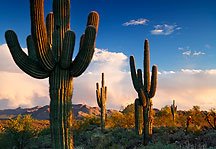 The following is a transcript of a speech from Senator Barack Obama last fall, in which he focused on America's energy future.
The following is a transcript of a speech from Senator Barack Obama last fall, in which he focused on America's energy future.
While I understand it's a lengthy read (and therefore lengthy post), I find it to offer a compelling case study on the future of clean energy under an Obama Administration.
While this event occurred a few months back, it's anything but outdated... it basically outlines Obama's view of how to address issues surrounding energy needs and the environment in the future... a policy that will help the country move forward in the right direction.
I'll let the distinguished Junior Senator from Illinois take the floor now... S
Portsmouth, NH | October 08, 2007
"Two weeks ago, representatives from some of the world's largest emitters of greenhouse gases were invited to Washington by the President for a global conference on climate change.
For a brief moment, there was a hope that maybe this conference would be different - that maybe America would finally commit to the steps that nearly every scientist and expert believes we must take; that maybe the planet's only superpower would finally lead the world - or at the very least, follow it - in taking on the planet's greatest threat.
Instead, the world traveled thousands of miles to Washington only to find that Washington is still miles away from the world in its willingness to address one of the most urgent challenges of our generation. Some of the attendees said they were amazed at how isolated the White House view had become. Others dismissed the President's credibility entirely. And another headline noted that when it comes to the global debate on climate change, our country is struggling just to stay relevant.
Struggling just to stay relevant.
That is not the America we know. It is not the America we believe in. We are a nation that has led the world ever since the moment a lowly band of colonists proved that freedom could triumph over tyranny. We are the country that summoned the courage of its people to build an arsenal of democracy that freed a continent and brought peace to a world at war. We are a land of moon shots and miracles of science and technology that have touched the lives of millions across the planet. And when that planet is challenged or when it is threatened, the eyes of the world have always turned to this nation as the "last, best hope of Earth."
That is the America I want to lead as President. I believe that when it comes to the issue that will determine the very future of life on this Earth, we are still Earth's best hope. And when the world arrives at the doorstep of the White House to hear what America has to say about climate change, I will let them know that America is up to the challenge. That America is ready to lead again.
We have not fallen behind on energy due to a lack of ingenuity or initiative from the American people. I have seen too much innovation and possibility in this country to believe that. Right here in New Hampshire, I've filled up at a biodiesel pump at UNH, where this year students and faculty will remove over 200 tons of carbon dioxide from the atmosphere. New Hampshire is already reducing its greenhouse gas pollution as part of the Regional Greenhouse Gas Initiative, and thanks to the leadership of Senator Martha Fuller Clark and Governor Lynch, you'll get 25% of your energy from renewable sources by 2025. Keene is one of America's greenest cities, and I understand that 164 towns have now passed a resolution demanding that Washington take action on climate change
But Washington hasn't acted; and that is the real reason why America hasn't led.
Washington's failure to lead on energy is the failure of a President who spent most of his time in office denying the very existence of global warming - a President who put more faith in the spin of a science fiction writer than the science facts of real experts. It's the failure of an Administration that developed America's energy policy with a secret task force that opened the door to oil lobbyists and then shut it to every other viewpoint. It's a failure of leadership that has never called on the American people to do anything more than go shopping.
And it's also a failure of our politics that pre-dates the presidency of George W. Bush. We have heard promises about energy independence from every single U.S. President since Richard Nixon - Republicans and Democrats. We've heard proposals to curb our use of fossil fuels in nearly every State of the Union address since the oil embargo of 1973. Back then we imported about a third of our oil. Now we import over half. Back then global warming was just the theory of a few scientists. Now it is a fact that threatens our very existence.
The truth is, our energy problem has become an energy crisis because no matter how well-intentioned the promise - no matter how bold the proposal - they all fall victim to the same Washington politics that has only become more divided and dishonest; more timid and calculating; more beholden to the powerful interests that have the biggest stake in the status quo.
There are some in this race who actually make the argument that the more time you spend immersed in the broken politics of Washington, the more likely you are to change it. I always find this a little amusing. I know that change makes for good campaign rhetoric, but when these same people had the chance to actually make change happen, they didn't lead. When they had the chance to stand up and require automakers to raise their fuel standards, they refused. When they had multiple chances to reduce our dependence on foreign oil by investing in renewable fuels that we can literally grow right here in America, they said no.
Now, I know that some of these policies are difficult politically. They aren't easy. But being President of the United States isn't about doing what's easy. It's about doing what's hard. It's about doing what's right. Leadership isn't about telling people what they want to hear - it's about telling them what they need to hear.
When I arrived in the U.S. Senate, I wanted to do whatever I could to make real progress toward energy independence. I reached across the aisle to pass a law that will give more Americans the chance to fill up their cars with clean biofuels. I passed a law that will fuel the research needed to develop a car that will get 500 miles to the gallon. I even voted for an energy bill that was far from perfect because I was able to ensure that it contained some real investments in renewable sources of energy. And I've fought to eliminate the tax giveaways to oil companies that were slipped into that bill - oil companies that have spent half a billion dollars lobbying Congress in the last ten years while their profits have risen to record highs.
And I did something else. I knew that America hadn't raised the fuel standards for our cars in twenty years. Even though we had the technology on the shelf. Even though Japanese car companies that make more fuel-efficient cars are running circles around our own car companies. Even though we send hundreds of millions of dollars a day to some of the world's most dangerous regimes for their oil.
So I decided to try something new. I reached across the aisle to come up with a plan to raise our fuel standards that won support of lawmakers who had never supported raising fuel standards before. And I didn't just give a speech about it in front of some environmental audience in California. I went to Detroit, I stood in front of a group of automakers, and I told them that when I am President, there will be no more excuses - we will help them retool their factories, but they will have to make cars that use less oil.
Now I have to admit - the room was pretty quiet after that. But I said what I did because I believe America has had enough of politicians who just tell everyone what they want to hear. We have to tell people the truth. And the truth is that we can't afford to let the same old politics stand in the way of our future anymore.
We can't afford the same kind of caution when the future of our security is at stake. We know that the money that America spends on foreign oil is funding both sides of the war on terror; that it pays for everything from the madrassas that plant the seeds of terror in young minds to the Sunni insurgents that attack our troops in Iraq. We know this money corrupts budding democracies and allows dictators from hostile regimes to threaten the international community. It even presents a target for Osama bin Laden, who has told al Qaeda to, "focus your operations on oil, since this will cause [the Americans] to die off on their own."
We can't be afraid to stand up to the oil and auto industry when the future of our economy is at stake. When we let these companies off the hook; when we tell them they don't have to build fuel-efficient cars or transition to renewable fuels, it may boost their short-term profits, but it is killing their long-term chances for survival and threatening too many American jobs. The global market is already moving away from fossil fuels. The question is not if a renewable energy economy will thrive in the future, it's where. And if we want that place to be the United States of America, we can't afford to wait any longer.
Most of all, we cannot afford more of the same timid politics when the future of our planet is at stake. Global warming is not a someday problem, it is now. In a state like New Hampshire, the ski industry is facing shorter seasons and losing jobs. We are already breaking records with the intensity of our storms, the number of forest fires, the periods of drought. By 2050 famine could force more than 250 million from their homes - famine that will increase the chances of war and strife in many of the world's weakest states. The polar ice caps are now melting faster than science had ever predicted. And if we do nothing, sea levels will rise high enough to swallow large portions of every coastal city and town.
This is not the future I want for my daughters. It's not the future any of us want for our children. And if we act now and we act boldly, it doesn't have to be. But if we wait; if we let campaign promises and State of the Union pledges go unanswered for yet another year; if we let the same broken politics that's held us back for decades win one more time, we will lose another chance to save our planet. And we might not get many more.
I reject that future. I would not be running for President if I didn't believe that this time could be different. Not because I have some perfect solution that every other expert and candidate has somehow missed. Not because I think I can lock myself in the White House with a secret task force and get this done on my own. But because I believe the American people are ready for a President who can unite us around a common purpose again. I believe that we are ready to lead again.
Make no mistake - developing the next generation of energy will be one of the greatest challenges that this generation of Americans will ever face. It will not be easy. It will not come without cost or without sacrifice. And if anyone tries to tell you otherwise, they are either fooling themselves or trying to fool you.
I will set big goals for this country as President - some so large that the technology to reach them does not yet exist. But that has not stopped us before. When President Roosevelt's advisors informed him that his goals for wartime production were impossible to meet, he waved them off and said "believe me, the production people can do it if they really try." And they did. When the scientists and engineers told John F. Kennedy that they had no idea how to put a man on the moon, he told them they would find a way. And we found one.
I believe we will again.
In the speech I gave in Detroit, I laid out the first part of my comprehensive energy plan - a proposal that will require our cars to use less oil and our fuels to use less carbon. It's a proposal that alone removes 50 million cars' worth of pollution from the road and reduces our oil consumption 2.5 million barrels a day by 2020 - the equivalent of all the oil we import from the Persian Gulf today.
Today I want to lay out the second part of my plan - a set of proposals that will allow America to lead the world in combating global climate change. From the moment I take office as President, I will call together scientists and entrepreneurs; heads of industry and labor; Democrats, Republicans and Americans from all walks of life to help develop and deploy the next generation of energy that will allow us to build the next generation's economy.
After all, in meeting the challenges of earlier generations, we didn't just end a costly war or beat the Soviets to the moon - we also unleashed opportunities we had never dreamed of. The GI Bill sent an entire generation of Americans - including my grandfather - to college and then on to the middle-class. Legions of scientists and engineers emerged from our race to space whose discoveries and innovations have forever changed the world.
This same opportunity exists today. That's why my plan isn't just about making dirty energy expensive, it's about making clean energy affordable - a project that will create millions of new jobs and entire new industries right here in America.
The first step in doing this is to phase out a carbon-based economy that's causing our changing climate. As President, I will set a hard cap on all carbon emissions at a level that scientists say is necessary to curb global warming - an 80% reduction by 2050. To ensure this isn't just talk, I will also commit to interim targets toward this goal in 2020, 2030, and 2040. These reductions will start immediately, and we'll continue to follow the recommendations of top scientists to ensure that our targets are strong enough to meet the challenge we face.
In addition to this cap, all polluters will have to pay based on the amount of pollution they release into the sky. The market will set the price, but unlike the other cap-and-trade proposals that have been offered in this race, no business will be allowed to emit any greenhouses gases for free. Businesses don't own the sky, the public does, and if we want them to stop polluting it, we have to put a price on all pollution. It's time to make the cleaner way of doing business the more profitable way of doing business.
There is no doubt that this transition will be costly in the short-term. To make it easier, we will provide assistance to Americans who need help with their energy bills. We'll help families make their homes more energy efficient, and we'll help workers and factories retool their facilities so they can compete and thrive in a clean energy economy. And once we make America more energy efficient and start producing more renewable energy, we will save money and bring energy costs down in the long-run. But we must act now.
Once we make dirty energy expensive, the second step in my plan is to invest $150 billion over the next decade to ensure the development and deployment of clean, affordable energy.
That starts with the next generation of biofuels. We know that corn ethanol has been the most successful alternative fuel we have ever developed. I've been a champion for ethanol. In just two years, the Renewable Fuel Standard I helped pass has sparked an historic expansion of ethanol production. It has helped displace foreign oil and strengthen our rural economy. And we should fight the efforts of big oil and big agri-business to undermine this emerging industry.
But the truth is, corn ethanol is neither the perfect nor the permanent answer to our energy challenge. There are legitimate economic and ecological concerns about an over-reliance on corn-based ethanol. And even if we double or triple its production, it won't replace even a tenth of our demand for gasoline. That's why we must invest in the next generation of advanced biofuels like cellulosic ethanol that can be made from things like switchgrass and woodchips. The struggling paper mills in New Hampsire would be back in business if they could use wood to produce biofuels. We should set a goal to produce the first two billion gallons of advanced biofuels by 2013. And we should make sure that more local farms and local refineries have the chance to be a part of this new industry.
We'll also invest in clean energy sources like wind power and solar power, so that by 2025, America can meet a new standard that will require 25% of all our electricity to come from renewable sources.
And we must find a way to stop coal from polluting our atmosphere without pretending that our nation's most abundant energy source will just go away. It won't. It will also require taking steps to ensure that China's coal emissions are curbed as well. Already, some coal pollution from China's dirty plants is making its way to California. That's why we must invest in clean coal technologies that we can use at home and share with the world. Until those technologies are available, I will rely on the carbon cap and whatever tools are necessary to stop new dirty coal plants from being built in America - including a ban on new traditional coal facilities.
We will also explore safer ways to use nuclear power, which right now accounts for more than 70% of our non-carbon generated electricity. We should accelerate research into technologies that will allow for the safe, secure treatment of nuclear waste. As President, I'll continue the work I began in the Senate to ensure that all nuclear material is stored, secured and accounted for - both at home and around the world. There should be no short cuts or regulatory loopholes - period.
Many of these clean energy technologies - from biofuels to solar power to carbon sequestration - are being developed in research labs and facilities all across America at this very moment. The problem is they might never get further than that. U.S. venture capital funding does a great job investing in research and development, but we don't do enough to take the risk out of bringing new discoveries to the wider marketplace. And so we see technologies that are invented here in America - like wind turbines, solar panels, and compact fluorescent bulbs - developed overseas and then sold back to American consumers.
This will change when I am President. I will launch a Clean Technologies Venture Capital Fund that will provide $10 billion a year for five years to get the most promising clean energy technologies off the ground. This venture capital fund will get new technologies from the lab to the marketplace so that in the next few years, the American economy can benefit from America's innovations.
The third step in my plan to combat climate change is to call on businesses, government, and the American people to make America 50% more energy efficient by 2030. This is by far the fastest, easiest, and cheapest way to curb our emissions and save money at the same time. Since DuPont implemented an energy efficiency program in 1990, the company has significantly reduced its pollution and cut its energy bills by $3 billion, and cities like Keene and Portland, Oregon have led in meeting new efficiency standards. There is no reason the rest of America can't do the same.
We will start by dramatically improving the efficiency of our buildings, which currently account for nearly half of all carbon emissions in America today. When I am President, we'll set a goal of making our new buildings 50% more efficient within several years. The federal government will lead by making all of its buildings carbon neutral by 2025. And I will set a national goal of making all new buildings in America carbon neutral by 2030.
We will also start replacing our outdated power grid with a digital smart grid so that we don't lose precious energy and billions of dollars like we did in the 2003 New York City blackout. We'll follow the lead of states like California and change the way utilities make money so that their profits aren't tied to how much energy we use, but how much energy we save. Finally, we know that if every home in America replaced just five incandescent light bulbs with five compact fluorescent bulbs, it would eliminate the need for twenty-one power plants. We'll do one better. I will immediately sign a law that begins to phase out all incandescent light bulbs - a measure that will save American consumers $6 billion a year on their electric bills.
Now, none of these steps will happen overnight. They will take time, they will take sacrifice, and they will take a sustained commitment from the American people. As President, I will lead this commitment. I will not be outlining these goals in my State of the Union and then walk away when they become too difficult. I will report to the American people every year on the State of our Energy Future, and let you know the progress we've made toward an 80% emissions reduction by 2050, toward replacing over a third of our oil consumption by 2030, and toward improving our energy efficiency 50% by 2030. I will also make America's energy security a fundamental tenet of our national security by preparing our military to deal with threats posed by climate change.
And there is one step I will take as soon as possible.
From the moment I take office, I will invite the world back to Washington and let it be known that the United States of America is ready to lead again. That we are ready to rejoin the community of nations in taking on the greatest challenge of this generation.
I will personally reach out to the leaders of the biggest carbon emitting nations in both the developed and developing world and ask them to join America in creating a new Global Energy Forum that will lay the foundation for the next generation of climate protocols. It will complement - and ultimately merge with - the much larger negotiation process underway at the UN to develop a post-Kyoto framework. I will be in constant contact with these leaders to develop concrete, feasible emissions targets that all of us will meet. We will also work to build an alliance of oil-importing nations and work together to reduce our demand, just like the OPEC nations strategize on supply.
And as we develop new forms of clean energy here at home, we will share our technology and our innovations with all the nations of the world. If we can build a clean coal plant in America, China should be able to as well. If we find a way to harness the next generation of biofuels, India will know how to do it too. And as we tackle under-development in impoverished nations, we will use what we know to help them reduce the negative impacts of climate change and build a clean energy future.
Recently, the director of a nonprofit that helps promote clean energy policies in China said that the most frequent question he gets from the Chinese about every policy initiative he suggests is, "If it is so good, why aren't you doing it?" And it's the hardest question to answer. He said, "We can point to good examples that some American states, or cities, or companies are implementing...but we can't point to America."
I believe it's time the world could point to America again. I want the engineer in New Delhi to point to our green buildings as the kind he'd like to design for his country. I want the automaker in Tokyo to point to our cars as the model for all the world. I want the leaders of Europe and Asia; of Africa and South America to point to our diplomacy and our engagement and our ingenuity as the light that led us toward a new energy future in our time.
And most of all, I want our children and our children's children to point to this generation and this moment as the time when America found its way again. As the time when America overcame the division and the politics and the pettiness of an earlier era so that a new generation could come together and take on the most urgent challenge of this era. I am running for President of the United States to lead us toward this new era, and I ask all of you to join me in taking on the challenge that lies ahead. Thank you."
---Barack Obama
 The final part of a 6 part series on Barack Obama's Energy Policy.
The final part of a 6 part series on Barack Obama's Energy Policy.





















